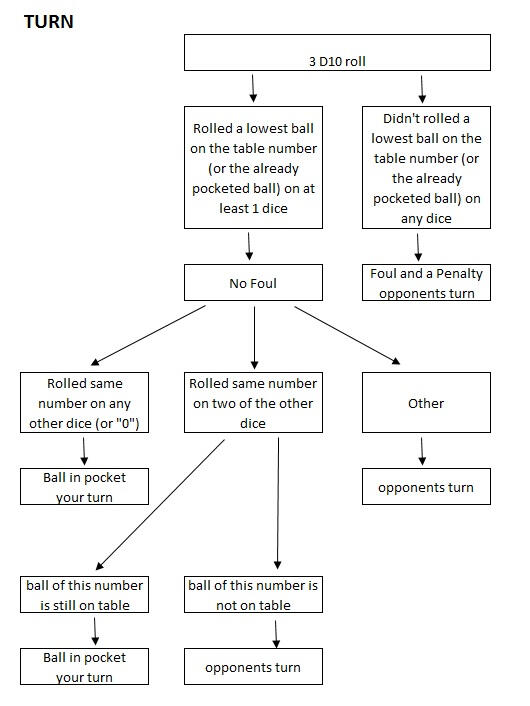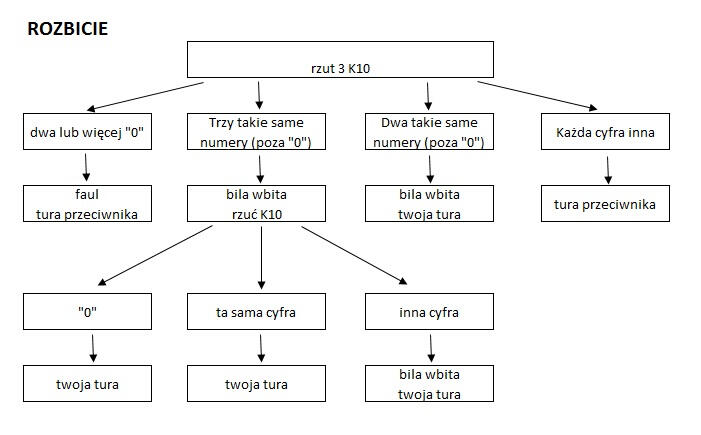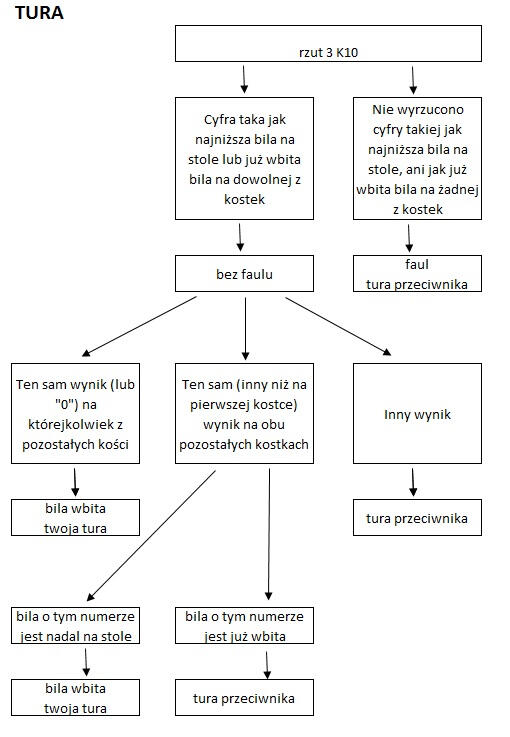9-ball dice game
(Polska wersja gry poniżej)
9-ball is a discipline of cue pool. It uses only 10 balls – 9 of them named 1 to 9 plus white. The task is to hit white with a cue stick, and make it hit the lowest ball currently on the table. If it doesn’t, than it’s a miss. As you hit a lowest ball with a white, you can put any of the balls into the pocket (most obviously the lowest number, as it is hit already, but after the white-lowest contact, any of the balls can fall into the pocket. If no ball falls into the pocket, then it’s opponents turn. If white falls, or doesn’t hit the lowest number, than it’s a foul, and a penalty. The player who puts a “9” into the pocket wins the game.

The 9-bill dice game is also a 2 player game. It's great as a party game (high randomization), for the tournament (2 rounds win), or as an adult game (whoever wins the round, loses one piece of clothing). You’ll need three 10-sided dice (D10), and a piece of paper to mark the balls on the table (or some tokens with 1-9 numbers on them). First, you’ll have all 1 to 9 balls on the table, so every number is seen. When you put any ball into the pocket, cross it out (or turn over the token).Rules:
First round is called a breaking. There is a chance to put any of the balls into the pocket. You simply roll all three D10:
- if you roll two same results on any dice (not “0”), this ball is in. Cross it out, and remain in the table – it’s still your turn. If “9” is in the pocket, you simply won the round.
- if you roll three same results, this ball is in pocket, and you get to roll one dice. If you roll a number of a ball still on the table, this ball is also pocketed.
- if there are no two same numbers, now it’s opponents turn.
- if you rolled two “0”, it’s foul, and a penalty (explained later).

Every round except for the breaking round is rolling all three dice:
- if on any dice there is a number of the lowest ball on the table, or the number of already pocketed ball, there is no foul, and read below. If not, there is a foul, and opponents turn.
- If on any of the other dice, there is the same number as on the first one (or “0”), this ball hits the pocket (cross it out). You play another round.
- If on two of the remaining dice there is the same number, this ball hits the pocket (cross it out), and you play another turn. If it was the “9” you win the round.
- In other cases there is an opponents turn, but no foul.If only the “9” ball remains on the table, a player has to roll a “9” and no pair on the other two dice (except for “9”s) to put the “9” into the pocket and win, and two “0”s means foul.Fouls and penalties:
- A player, that begins the turn after the opponents foul, gets to place one dice as he wants, and rolls only the two remaining dice. The result is checked as three dice were rolled.A player that put “9” into the pocket wins the roud. Next round starts with the breaking by the player, who didn’t break the previous round. The play continues up to the moment one of the player wins 11 rounds (full game of "9"), or till the moment you’ll both agree. Party version is a "2-rounds win" tournament.

Example 1:
Breaking Player 1: 2, 5, 6 – no pocket.
Player 2: 1, 3, 8 – no pocket, but no foul (“1” is hit)
Player 1: 1, 4, 4 – 4 into the pocket; 1, 0, 7 – 1 into the pocket (“1” and “0”); 4, 5, 7 – no pocket (but no foul – “4” is no longer on the table)
Player 2: 2, 5, 8 – no pocket
Player 1: 3, 4, 7 – no pocket
Player 2: 4, 4, 6 – pocketing the lowest, so “2”; 3, 5, 7 – no pocket
Player 1: 1, 1, 2 – lowest into the pocket, so “3”; 3, 3, 4 – “5” into the pocket; 5, 5, 0 – “6” into the pocket; 0, 4, 7 –„7” is in; 2, 6, 9 –„8” is in; Only „9” left, so you need two “9”s; 3, 4, 4 – no pocket.
Players play one by one, as long as one of them rolls “9” and no other pair, to win the round. If one of them rolls two “0”s, the other one may put a “9” on one dice, and roll the remaining ones to see if he win.Example 2:
Breaking Player 2: 3, 9, 9 – “9” is in, the golden break, player 2 wins the round.Example 3:
Breaking Player 1: 1, 3, 3 – „3” is in, player one remains by the table,
Player 1: 1, 4, 4. „4” is in; 2, 2, 5 – foul (no „1”, „0” or any of the put in - „3” nor „4”
Player 2: makes one of the dice „0” and rolls the remaining 2: 3, 4 – the lowest is in, so „1” is in the pocket; 4, 6, 9 – no pocket, no foul
Player 1: 3, 9, 9 – „9” is in (No foul, because „3” is already in the pocket, player 1 Wins this round. Now player 2 is breaking the next round (because player 1 did it this round).
WERSJA POLSKA
“Dziewiątka” to popularna odmiana bilarda, w którym używa się 10 bil – numerowanych od 1 do 9 oraz białej. Zadanie polega na trafieniu białą bilą w tę o najniższym aktualnie numerze na stole (podczas rozbicia jest to 1, później, w miarę wbijania kolejnych bil idziemy w górę). Po tym, jak biała uderzy w najniższy numer, może trafić w dowolny inny. Także bila już w ruchu może uderzać w inne bile. Jesli jakaś bila wpadnie po uderzeniu, strzał jest zaliczony i zawodnik uderza kolejny raz (nadal w najniższy numer). Jeśli jednak żadna nie wpadnie, przeciwnik podchodzi do stołu. Jeśli do łuzy wpadnie biała, albo biała nie dotknie jako pierwszej bili o najniższym numerze, następuje faul i przeciwnik dostaje szansę oraz ułatwienie. Grę wygrywa ten, kto jako pierwszy wbije do łuzy bilę z numerem „9”.

Kościana gra w „dziewiątkę”, także przeznaczona dla 2 graczy, świetna jako gra imprezowa (turniej do 2 wygranych rund), a także jako wersja rozbierana dla dorosłych (gracz przegrywający rundę zdejmuje jeden element garderoby). Opiera się na trzech kościach dziesięciościennych. Przyda się także kartka papieru z narysowanymi „bilami” numerowanymi od 1 do 9, które będziemy wykreślać po wbiciu, lub żetony ponumerowane od 1 do 9, które będziemy odwracać.Zasady:
Pierwsza runda polega na rozbiciu układu bil mocnym uderzeniem, które daje szansę na wbicie właściwie dowolnej bili. Aby zobaczyć jak poszło, gracz rozbijający rzuca trzema kostkami:
- jeśli uzyska dwie takie same cyfry (poza zerem), ta bila wpadła do łuzy. Jeśli to „9”, wygrał rundę. Jeśli dowolna inna, należy ją wykreślić z puli (lub odwrócić żeton).
- jeśli wyrzucił 3 takie same cyfry (nie zera), wbija tę bilę, oraz rzuca jedną kostką. Jeśli wyrzuci numer bili, która nadal jest na stole, wbija także ją.
- jeśli nie uzyska dwóch takich samych numerków, żadna bila nie wpadła, następuje zmiana przy stole i zaczyna się tura drugiego gracza.
- jeśli wyrzuci dwa zera, nastąpił faul (o faulach dalej).

Każda kolejna tura (po rozbiciu) toczy się tak samo – gracz, który jest przy stole, rzuca trzema kostkami:
- jeśli na jednej z nich (dowolnej) jest najniższa obecnie cyfra lub taka, która jest już wbita, gracz trafił w bilę o najniższym numerze (nie ma faulu), czytaj poniżej. Jeśli nie, przychodzi tura przeciwnika i ma miejsce faul.
- jeśli na dowolnej innej kostce jest taka sama wartość jak na pierwszej (lub „0”), bila z najniższym numerem zostaje wbita (nalezy ją wykreślić z puli), a gracz pozostaje przy stole.
- jeśli na obu pozostałych bilach jest ta sama cyfra (inna niż na pierwszej), bila o tym numerze zostaje wbita (należy ją wykreślić z puli), a zawodnik pozostaje przy stole.
- w pozostałych przypadkach następuje tura przeciwnika, ale nie ma faulu.Jeśli na stole pozostanie tylko „9”, aby ją wbić należy wyrzucić „9” przynajmniej na jednej kostce i nie wyrzucić dwóch takich samych wyników na pozostałych kostkach (poza „9”). Dwa „0” oznaczają faul.Rozpatrywanie fauli:
- gracz, który podchodzi do stołu po turze przeciwnika, ustawia na jednej z kostek dowolny wynik, a rzuca jedynie pozostałymi dwoma. Wyniki rozpatruje tak, jak normalnie.Gracz, który wbił „9” wygrywa rundę. W następnej rundzie następuje zmiana rozbijającego. Gra się aż do momentu wygrania 11 rund przez jednego gracza. Można tez umówić się na inne zakończenie. Wersja imprezowa to turniej do 2 wygranych rund.

Przykładowa rozgrywka / przykład 1:
Rozbicie Gracz 1: wypada 2, 5, 6. Nie ma wbicia.
Gracz 2: 1, 3, 8. Nie ma wbicia.
Gracz 1: 1, 4, 4 - Wbicie bili numer 4; 1, 0, 7 – wbicie bili numer 1; 4, 5, 7 – nie ma wbicia (ale nie ma faulu, bo bila nr 4 jest już wbita.
Gracz 2: 2, 5, 8. Nie ma wbicia.
Gracz 1: 3, 4, 7. Nie ma wbicia (znów bez faulu, bo wyrzut „4”).
Gracz 2: 4, 4, 6 – wbicie najniższej, czyli „2”; 3, 5, 7. Nie ma wbicia.
Gracz 1: 1, 1, 2 – wbicie najniższej, czyli „3”; 3, 3, 4 – wbicie najniższej, czyli „5”; 5, 5, 0 – wbicie najniższej, czyli „6”; 0, 4, 7 – wbicie „7”; 2, 6, 9 – wbicie „8”; Pozostała jedynie „9”. 3, 4, 4 – bez wbicia.
Gracze rzucają więc na zmianę, aż któryś z nich wyrzuci „9”, bez innej pary na pozostałych kostkach. Jeśli któryś z Graczy wyrzuci dwa zera, drugi Gracz może ustawić dziewiątkę na jednej z kostek i rzucić pozostałymi dwiema.Przykład 2:
Rozbicie Gracz 2: Wypada 3, 9, 9. Złote rozbicie, dziewiądka wpada, Gracz 2 wygrał tę rundę.Przykład 3:
Rozbicie Gracz 1: Wypada 1, 3, 3. „3” wbita, gracz 1 nadal przy stole.
Gracz 1: 1, 4, 4. Wpada „4”; 2, 2, 5 – faul (nie została wyrzucona „1”, „0” ani żadna z nieobecnych bil, czyli „3” ani „4”).
Gracz 2: ustawia na jednej z kostek „0” i rzuca pozostałymi, 3, 4 – wbita zostaje najniższa, czyli „1”; 4, 6, 9 – żadna nie została wbita (ale nie ma faulu, bo „4” nie ma na stole).
Gracz 1: 3, 9, 9 – „9” zostaje wbita („3” nie ma na stole, więc zalicza dotknięcie najniższej) i gracz 1 wygrywa rundę. W kolejnej rundzie rozbija gracz 2 (na zmianę).